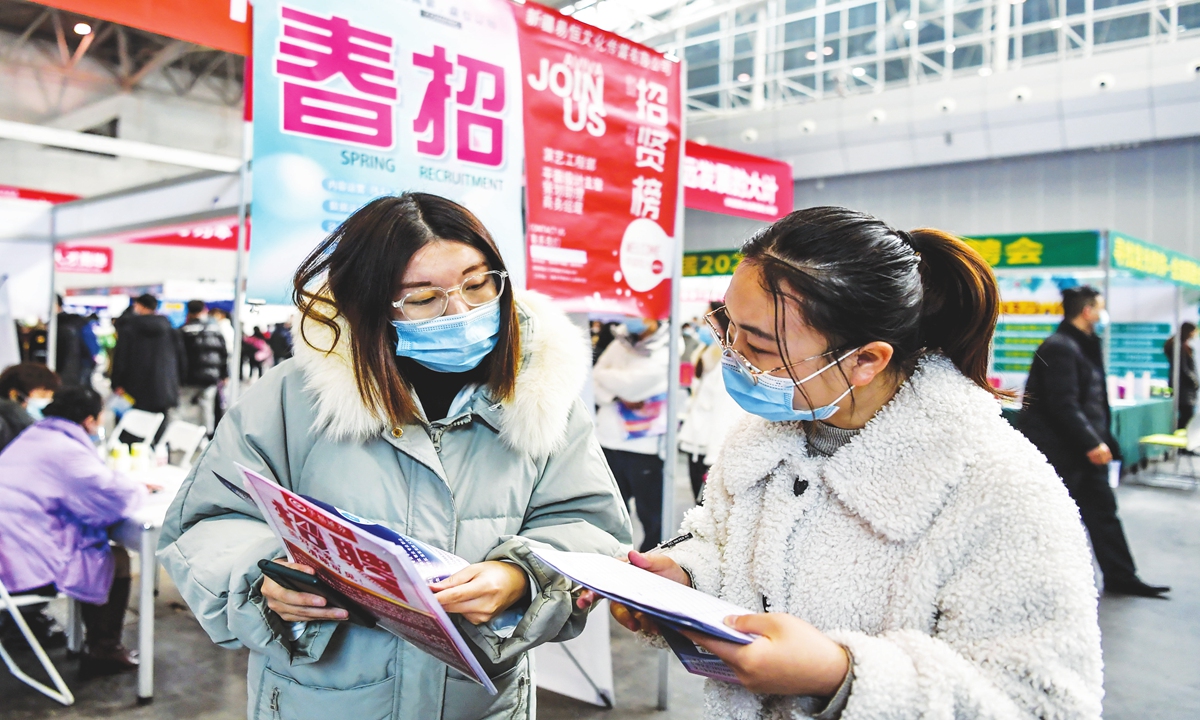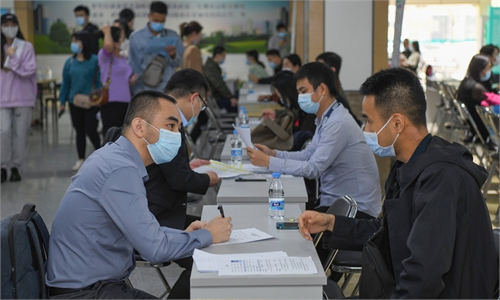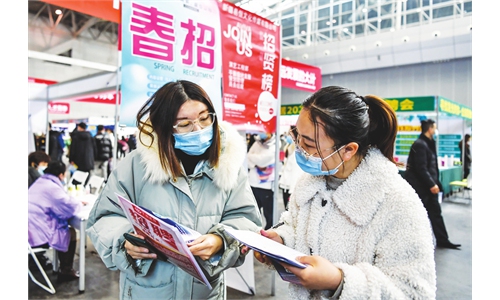
A job applicant exchanges information with a recruiter at a spring job fair held in Urumqi,Northwest China's Xinjiang Uygur Autonomous Region on Feburary 26, 2022. Photo: cnsphoto
China's job market faced growing pressure in the first three months of 2022, as the urban surveyed unemployment rate continued to rise due to the complex international situation and sporadic flare-ups of COVID-19 domestically, and pressure could further intensify in coming months, an official said on Monday, vowing measures to ensure a stable job market.A total of 2.85 million new urban jobs were created in the first quarter of 2022, with the urban surveyed unemployment rate averaging 5.5 percent, 0.1 percentage points higher than the same period of 2021, the National Bureau of Statistics (NBS) said on Monday.
In March, the urban unemployment rate stood at 5.8 percent, an increase of 0.5 percentage points compared with the 2021 level, reflecting difficulty in the operation and production of enterprises, as well as increasing pressure on the job market, NBS spokesperson Fu Linghui told a press briefing.
According to Fu, in January and February, the unemployment rate rose due to the increase in job seekers changing jobs following the Spring Festival. Based on experience, after March, most job seekers find work, which would usually lead the rate to decline. However, the epidemic has disrupted the normal recruitment peak.
"Entering March, a number of Chinese large cities like Shanghai, Shenzhen and Guangzhou were hit by COVID-19 flare-ups, affecting the work and operation of enterprises, especially in the secondary and services sectors, which support a large number of jobs," Zhang Yi, CEO of iiMedia Research Institute, told the Global times on Monday.
Some local anti-epidemic measures, including suspension of local economic activity as well as restrictions on the movement of people across provinces may also have had an impact on local and cross-provincial recruitment, Zhang said.
Experts also linked layoffs seen in the private education and online platform sectors at the beginning of the year to the rise in the jobless rate.
In March, the unemployment rate for the main employment group, which includes those aged 25 to 59, stood at 5.2 percent, higher than the 4.8 percent recorded in January and February.
The pressure on the job market in the second quarter is still heavy, Li Changan, professor of the Academy of China Open Economy Studies at the University of International Business and Economics, told the Global Times on Monday.
According to the NBS, more than 10 million graduates will enter the job market this year, creating a burden on the employment situation.
However, China's employment will remain stable despite the complex international situation and the outbreak of the epidemic in some Chinese cities, Fu said, adding that the government is supporting the real economy, and stepping up tax and fee reductions and actions that are conducive to addressing the difficulties faced by enterprises and ensuring a stable job market.
Li called for targeted support for small and medium-sized enterprises (SMEs) built on predictable monetary and fiscal policies like Friday's reserve requirement ratio (RRR) cut, because SMEs can help address more than 70 percent of domestic employment pressure.
Fu noted that the government will further strengthen vocational skills training and employment support for key groups, including college students and migrant workers.


